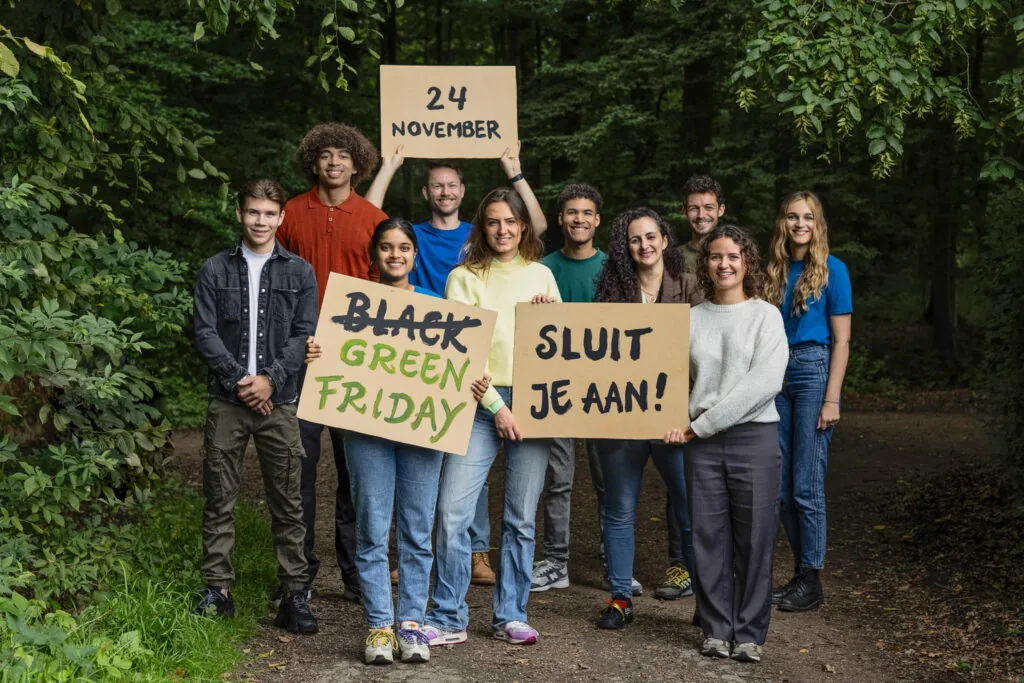The sustainable answer to Black Friday
November 16, 2023

November 16, 2023

⏰ Estimated reading time: 4 minutes
High discounts, shopping carts full of unnecessary purchases and people pushing each other aside in front of the entrance of the store. This was the video footage we saw more than a decade ago of Black Friday, the shopping festival around Thanksgiving in the United States.
In the meantime, Black Friday has also become an annual phenomenon, but is it still up to date? More and more retailers want to become more sustainable and Generation Z no longer makes purchases if the product is not produced or packaged in a green way. Time for a counter-narrative, called Green Friday.
Joly Bogers has been working as a Fundraiser and Project Manager at the Trees for All Foundation for over four years now. “With the Green Friday movement, the foundation is making a statement against Black Friday. A day that causes a lot of overconsumption worldwide and therefore has a major, negative impact on the climate.”
The first company to participate in the Green Friday promotion was Dille & Kamille, a Dutch retail chain that specializes in home and garden products. Five years ago, this company decided to plant trees on Black Friday instead of giving discounts. Last year, more than 260 large and small companies participated in this counter-movement of Trees for All. At the moment, the counter stands at more than 165 companies.
Bogers explains: “The aim of the campaign is to create awareness among companies and consumers. Black Friday motivates people to make unnecessary purchases through misleading advertisements. We think it’s important to make consumers aware of these impulse purchases and we encourage companies to stop participating in these big discounts. All participating companies are committed to planting trees at home and abroad on that day. We have already planted more than 60,000 trees.”
Companies that want to participate in the Green Friday promotion must adhere to a few rules. For example, they ask companies not to offer discounts, but to set up a Green Friday promotion that is not linked to selling products. In this way, consumers are not tempted to make unnecessary purchases. Otherwise, this would be called greenwashing. These are commercials with the promise that the company will plant a tree with every purchase. Consumers are thus tempted to make unnecessary purchases again.
Green Friday, Bring Back Friday or Future Friday are all initiatives to create awareness, but also to inspire other companies. For example, Dille & Kamille has been closing its doors during Black Friday for a few years in a row and they are going into nature with the entire company. Ikea is being transformed into a thrift store where people can trade in their old furniture and the ANWB (a Dutch organization that started as a cycling association but has since evolved into a broad service provider with a focus on mobility, tourism, and leisure) set up an outdoor cinema last year with a repair café next to it where things could be repaired instead of buying something new.
Beaver, a company that sells outdoor gear, is also embracing the ethos of Green Friday with their “For Future Fridays” initiative. They invite customers to extend the life of their products by offering free shoe care and a 50% discount on clothing repairs. This approach incentivizes customers to retain and maintain existing items, rather than purchase new ones, embodying Green Friday’s core values.
The fact that companies are increasingly turning away from Black Friday is linked to the fact that they prefer to become more sustainable. Stakeholders, employees and consumers are looking for companies with a sustainable image and within that concept, an action like Black Friday no longer fits, the concept is outdated.
On the Trees for All website you can see which companies are participating in the Green Friday promotion. This is not only convenient for the consumer, but also for other businesses. It provides a network for organizations that want to become greener and more sustainable and they achieve this by working together and supporting each other.
There are also all kinds of opportunities for e-commerce companies to participate in the promotion. “During Green Friday, e-commerce companies can engage customers in various ways. This can be done, for example, by planting a tree for every customer who signs up for the newsletter that day. They can organize an afternoon of exchanging clothes and items for colleagues and customers, so that no one has to buy anything new that day. Or the company posts a post on social media about Green Friday and for every response they get to the post, they donate a tree. On our website you will find a toolkit with texts, images and ready-to-use social media posts, a poster and the logo of Trees for All. In this way, we try to make it as easy as possible for our participants,” says Bogers.
Greenwashing is the process by which a company tries to falsely appear as environmentally friendly. If, as a company, you also want to take (the first) steps in sustainability, it is advisable to look at the transparency of your Green Friday promotions. Is there actually a positive impact on the environment? Is this promotion not intended for commercial purposes? As a participant of Trees For All, you will also be made aware of this and they offer a network and support for companies that really want to become more sustainable. To make a positive impact together.
The success and authenticity of Green Friday initiatives depend on the integrity and completeness of their implementation. If companies actually follow the guidelines and invest in sustainable actions without emphasizing consumption, then this is a genuine attempt at sustainability, rather than greenwashing.
In recent years, retailers have had to deal with pressure on their commercial objectives, which has made making their production process more sustainable a somewhat lower priority for some organizations.
Nevertheless, Bogers is optimistic about the future of Green Friday. “As long as we keep buying, companies will continue to offer discounts. Nevertheless, we see Green Friday as a multi-year plan in which we hope that more and more retailers will participate. With this counter-narrative, we not only want to make people aware of the negative effects of Black Friday on our climate, but also underline how important it is to plant trees.”
All Green Friday participants can plant their donated trees in the Green Friday Forest. That event will take place on November 24 in the recreation area Het Twiske, near Amsterdam. The participating companies are not obliged to co-plant, but they are fantastic to do.

Don't miss a thing.
Subscribe to our latest blog articles.